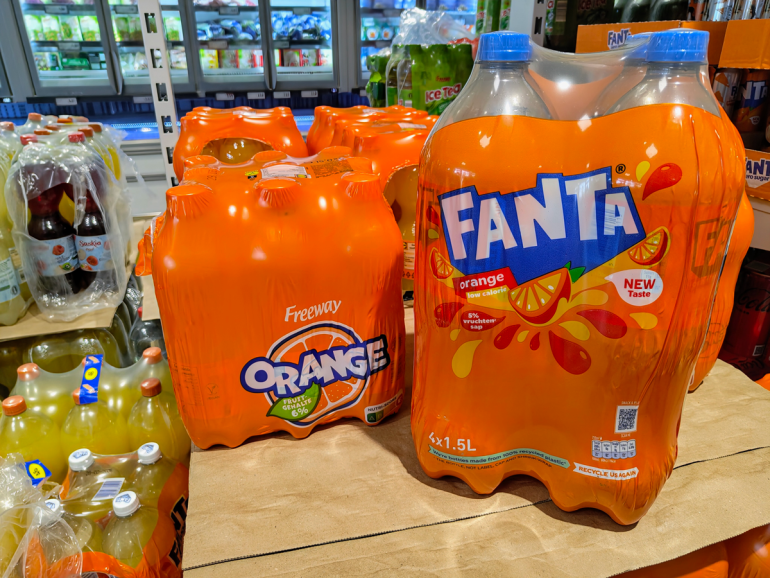Every brand wants it: to be distinctive. Whether it is a catchy logo, eye-catching packaging or a strong brand image – the question always remains: how distinctive are you really? We regularly see situations in which the line between inspiration and imitation seems to blur. A recent example of this is Lidl, who with the new packaging of their own brand soft drinks leans remarkably close to the design of large A-brands. But where is the line between strengthening your own brand and profiting from the strength of another?
Don’t I know you from somewhere?
Brands like Coca-Cola and Fanta are not only strong and distinctive because of their taste and brand experience, but also because of their clear visual recognition. Think of the red and white color palette of Coca-Cola or the playful font and orange of Fanta.
These elements – known as distinctive brand assets – ensure that consumers make the association with the brand without even having to explicitly mention the brand name. This is exactly what gives strong brands distinctiveness. And why consumers get a strong sense of trust and quality as soon as they see these elements.
You will understand that Coca-Cola and Fanta spend a lot of marketing budget on displaying their brand to make and keep these associations as strong and recognizable as possible. But how do you do that as a smaller house brand with a smaller budget?
Fanta-stich of Copy-Cola?
Now that Lidl has given their own brand soft drinks a new look, it is noticeable that the packaging looks very similar to that of its major competitors. (View the packaging here.) Lidl seems to be deliberately playing on the brand recognition of Coca-Cola and Fanta with the new design. However, the supermarket chain claims that this is purely coincidental and that they simply wanted to give their packaging a fresh update.
If this were Lidl’s strategy, the store would look different.
I’m not so sure about that myself, to be honest. It seems like they’re trying to find the balance between strengthening their own house brand and using the power of well-known brands. If this wasn’t a conscious choice, it would be a coincidence that the design turned out the way it did.
And if it had been a lesser-known local brand in another country, you could understand that, but that is of course not the case with Coca-Cola and Fanta.
And Lidl is right that their store does not fit the image of these A-brands at all. However, they do benefit from the idea that you buy high-quality products for a low price. After all, that is their own distinguishing feature. By designing packaging that shows just enough similarity to well-known brands, Lidl cleverly plays on the subconscious of the consumer.
This gives consumers a sense of familiarity and trust in the product, even if they know they are buying a private label.

Clever or misleading
But where is the line between cleverly using visual recognition and misleading the consumer? Legally, a brand may not confuse the consumer, but in practice this is often a grey area. Lidl has undoubtedly ensured that its packaging is sufficiently different from A-brands to avoid legal complications, but is that ethical?
By capitalizing on the associations consumers have with A-brands, private labels like Lidl profit from the reputation of their more expensive competitors, while at the same time offering their product at a lower price.
It seems that Lidl is aiming here to strengthen their own brand by staying close to the visual elements of the market leaders. But when do you go too far? When is the line between clever positioning and deception crossed?
When is the line between clever positioning and deception crossed?
Crisis in the fridge
For big brands like Coca-Cola and Fanta, this can be a threat to their brand values. If consumers buy a product that is very similar to an A-brand, but experience a different taste or quality, this can affect their perception of the original brand. Coca-Cola, for example, wants to avoid at all costs that people think that its cola tastes the same as that of a private label, simply because the packaging looks similar.
However, it is difficult for these A-brands to immediately threaten legal measures. After all, large supermarkets such as Lidl are important buyers of their products. Coca-Cola and Fanta are also simply on the shelves of Lidl, so as a brand you do not want to risk your relationship with these important sales channels.
The dilemma that many A-brands struggle with is how to protect their brand identity without creating unnecessary conflicts with large retailers. Therefore, an out-of-court settlement is often chosen.
Coca-Cola itself indicates that it has seen the Lidl packaging and is currently conducting a further assessment.

Strategy
What Lidl shows here is that the line between strengthening your brand and profiting from someone else’s brand values is very thin. It is also not the first time that the cheap supermarket has pulled this trick. In 2019, for example, they had a dispute with Grolsch, because their new beer ‘Kompaan’ was said to be very similar in name to the ‘Kornuit’ of the Gelderland brewer.
Ultimately, the dispute was resolved out of court just before the appeal, but it shows that Lidl is not afraid to push the boundaries of the law.
The big question remains whether this strategy is sustainable in the long term. For now, Lidl seems to be making clever use of brand recognition, but as always with such tricks: every strategy has risks. It could well be that this move ultimately leads to a legal issue that could end in real bubble trouble.
As long as Lidl balances on the edge of inspiration and imitation, it will remain exciting. But whether they stay on the safe side or ultimately go a step too far, one thing is certain: their soft drinks are attracting attention for the time being.
Source: www.frankwatching.com


